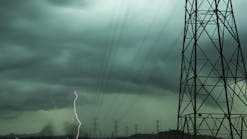In September 2018, residents and businesses in Fayetteville, North Carolina, U.S., braced for the arrival of Hurricane Florence. The military community located 60 miles (97 km) south of Raleigh, North Carolina, was no stranger to seasonal weather events, but no one could foresee the historic flooding and US$24 billion in damage that would occur as the storm slowed down for an extended stay in the Tar Heel State.
Florence turned into the storm of a lifetime as a result of the stalled weather patterns that caused the hurricane to move across the region at a snail’s pace. By the time the hurricane reached Fayetteville, residents were in for four days of unprecedented rainfall and damage. Florence ultimately dumped up to 20 inches (508 mm) of rain in certain parts of the area and left more than 50,000 customers without power.
For years, Fayetteville Public Works Commission (PWC) practiced and refined its emergency plan of operations to prepare for an event of this magnitude and to ensure it could respond at a moment’s notice. The utility knew supporting customers through the storm ultimately would require the hard work of every staff member and the right technology to get service restored as soon as possible.
Prepare For The Worst
The ability to identify and restore power outages efficiently is a core objective for any utility, particularly in the wake of severe weather. To support first-responder efforts, a communication network that can immediately pinpoint where system repairs are needed is key. The system also must provide mission-critical outage management data. A successful outage management strategy is driven by several customer service and business use cases, such as proactive outage alerts that reduce customer calls. Additionally, detailed accurate data can help to resolve outage root causes and improve customer interactions.
For Fayetteville PWC, these objectives were elevated because of its size. Fayetteville’s hometown utility is the largest public power provider in North Carolina, with more than 82,000 electric customers. A system was needed that would not only assist with customer communication but also help to restore service quickly. Because everything happens rapidly when severe storms hit, the team wanted to monitor the situation in real time and provide customers with accurate, up-to-date data throughout the storm. These goals called for a combination of infrastructure, software and services that work in concert to provide a holistic communications and support platform.
To streamline outage management and improve communications, Fayetteville PWC decided to make the move to a smart utility network from Sensus, a Xylem brand. The solution runs on the point-to-multipoint Sensus FlexNet communication network, a two-way system that produces real-time data. The private network architecture offers several advantages, including fast and accurate outage detection and more responsive issues resolution. The smart solution frees up time for utility management and maintenance staff to focus on restoring power for customers. The system also helps to eliminate capital investments, such as information technology resources, extra office space and specialized equipment.
Greater Coverage
Fayetteville PWC’s network is designed to reduce damage exposure because of its streamlined infrastructure. Thousands of miles of T&D lines can be lost in a storm; this leaves alternative communication systems vulnerable given their downstream meter dependency on an alternative hopping scheme. As a result, it might not be able to communicate its status in an outage. In contrast, Fayetteville PWC’s battery backup of the antenna tower collectors provides necessary data in the immediate aftermath of an outage, including which towers are without power and needing priority restoration.
Fayetteville PWC’s system also is suited for supporting superior outage detection through a framework of overlapping coverage. This enables the utility to find outage conditions and collect information needed for a fast power restoration process to help impacted customers. When the network experiences an outage, it can initiate a graceful shutdown when power loss occurs. First, the impacted end points go through the outage notification process. Base stations that lose their alternating-current power source will continue normal operations for data collection with an eight-hour backup battery.
Once the battery is exhausted, the base station will shut down and save any data not conveyed to the main system. Other active base stations can continue to receive transmissions from energized end points designed for overlapping coverage within the affected area.
The utility’s storm-hardened infrastructure would prove to be the key lifeline during Florence’s prolonged stay in the Fayetteville region. With the communications network staying intact during and after the storm’s aftermath, the utility was able to keep a pulse on its metering infrastructure and activate quickly when it was safe to begin power restoration efforts.
Riding The Storm
With its network acting as a compass, Fayetteville PWC’s team was hunkered down yet ready for action in the emergency response center when Hurricane Florence arrived. Every department within the utility supported storm-response efforts and each employee had an assignment, whether answering phones or updating social media. As the storm slowly made its way through the region, the utility used its network to stay on top of the situation. The system gave staff the ability to provide real-time updates to residents as well as send hourly notifications to local media channels and across social media to keep the public informed.
At the peak of the storm, 15 of 35 substations lost service. When the hurricane’s wrath finally began to subside, Fayetteville PWC used the communications network to initiate the outage restoration process immediately. Mutual aid workers from Alabama, Georgia and Tennessee offered additional help with downed powerlines and trees toppled on homes. Having the insights to know exactly where to put boots on the ground proved to be very beneficial. Of customers who had lost power, 97% were back up and running within 96 hours. Fayetteville PWC also kept the damage from impacting public safety during relief efforts, thanks to the accuracy of its system. Utility crews completed the restoration process with no reports of injuries.
The utility’s efforts to communicate proactively with customers during and after the prolonged hurricane did not go unnoticed. Fayetteville PWC was honored with a North Carolina City & County Communicators (NC3C) Excellence in Communications Award for its social media communications during the storm. The utility’s social media messages reached nearly half a million people, and the team had more than 1300 private message conversations with customers during the storm and the weeklong recovery efforts.
With Florence in the rearview, the utility plans to keep perfecting its network. Fayetteville PWC already has merged its system with its water meters across 93,000 endpoints, deploying Sensus iPERL and OMNI meters for advanced functionality. Now, the utility is installing Sensus Stratus electricity meters with voltage reduction capabilities to continue enhanced services for customers. The power and water provider is well prepared for the next big storm.
Ahead Of The Curve
Fayetteville PWC’s ability to build on its system with new applications that go beyond outage management highlights a key benefit of its communications network. Every day, utilities like Fayetteville PWC and others are living the reality of an increasingly digital distribution system. As a result, utilities can capture actionable information from electricity, water and gas meters, sensors, and other devices. By upgrading their systems with smart meters and other advanced sensors, utilities can capture vast amounts of data in real time and continue to maintain safe, accurate and reliable utility management. Smart analytics also enable utilities to extend capabilities, no matter if customers live in remote or densely populated metropolitan areas. The network serves as a springboard to begin seeing all the benefits smart infrastructure has to offer.
A smart utility communications network serves as a valuable steward in the journey toward smart utility infrastructure and internet-of-things deployment. Providing the ability to scale without major infrastructure overhauls, utilities can build a system and continue to evolve it no matter where they are in their journey. Electricity metering can be merged with water and gas, each operating independently on the same network and using the same infrastructure. As innovative applications come into demand — from distribution automation (DA), demand response and distributed energy resources (DER) to smart streetlighting — utilities can add these by leveraging or adding to the spectrum channels that currently are available within their network.
Smart Future
Indeed, smart utility solutions are changing everything. The paradigm of utility delivery and consumption is shifting with the application of technologies that advance daily. This is a good thing for the utility and the customer. Data and analytics will continue to advance the way utilities operate, from storm preparedness to general day-to-day business functions.
By leveraging smart tools strategically, utilities can ensure they have access to the right data at the right time to maximize service, operational efficiency and system safety. With data available on the entire distribution network, the possibilities are promising.






